2004 July
About Andrew Cusack
 Writer, web designer, etc.; born in New York; educated in Argentina, Scotland, and South Africa; now based in London.
Writer, web designer, etc.; born in New York; educated in Argentina, Scotland, and South Africa; now based in London. read more
News
Blogs
Reviews & Periodicals
Arts & Design
World
France
Mitteleuropa
Knickerbockers
Argentina
The Levant
Africa
Cape of Good Hope
Netherlands
Scandinavia
Québec
India
Muscovy
Germany
Academica
A Saint Returns Home
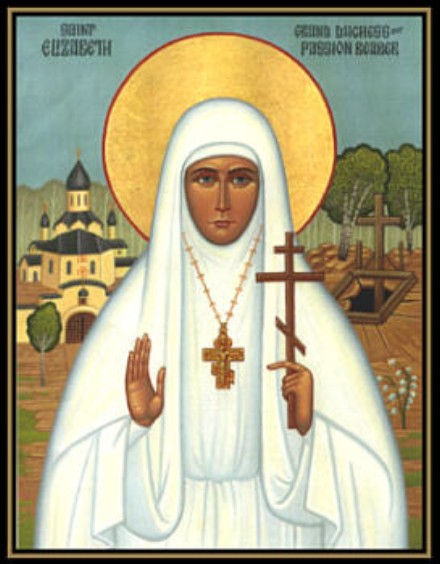
Relics of Saint Elizabeth Romanoff have been greeted enthusiastically by Muscovite crowds, according to Russia’s state-run ITAR-TASS news agency.
To discover the beautiful witness to Christ of Saint Elizabeth, read more about her at the Orthodox Christian Information Center and on the site of Fr. Demetrios Serfes. A statue of the holy Grand Duchess now graces the front of Westminster Abbey.
More Andreanic Fun
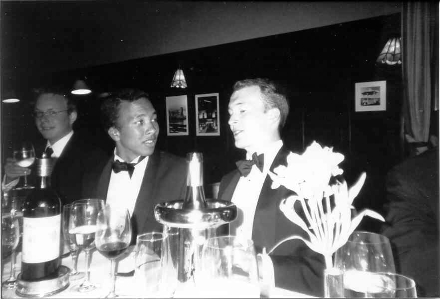
Behold, the only photo ever smuggled out of a Kensington Club dinner. Alright, I’ll admit it’s not a terribly interesting photo, but it’s the only one, so you’ll pardon that. I’m actually somewhat surprised I wasn’t fined a bottle of port or two for this, but I felt as a historian there ought to be some proof that the Kensington Club actually exists.
Here Ed Jackson turns to Rob Cockburn who explained some point about something. On the peripheral left is Michael Phillips, and on the dexter, Michael Gaster’s right arm (if my knowledge of the seating that evening is correct, which is doubtful).
Kens Club dinners are good fun, usually lasting from about seven-thirty until midnight, and they would be longer if only the Golf Hotel would oblige to keep its dining room open.
The Holy Whapping — Ad Multos Annos
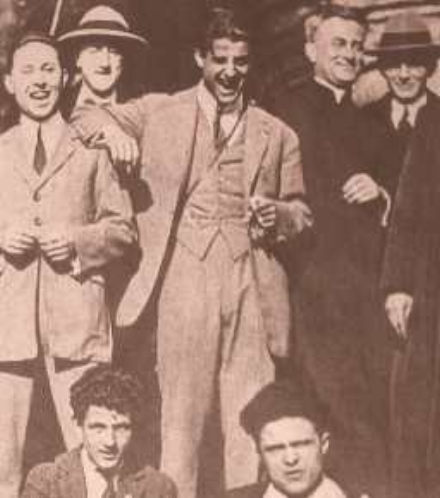
A hearty congratulations to the Brother and Sister Servants of the Holy Whapping who day and night maintain their sacred vigil at the Shrine of the Holy Whapping. The Shrine has reached its approximate first anniversary, and has dispensed much jolliness from its verdant e-pages.
It is to them, that I dedicate the above image of the Blessed Pier Giorgio Frassati, with his group of Catholic practical jokers “i Sinistri” – the Sinister Ones. Pier Giorgio, more than any other saint or holy person, deserves to be patron of the Shrine of the Holy Whapping for his unrelenting commitment to first holiness and second humour. If you don’t know about Pier Giorgio, then read the biography written by his sister.
And you can never have too much of the Emperor Charles and Empress Zita!
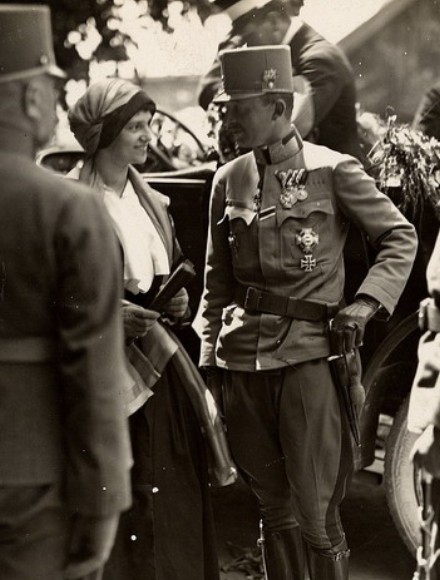
Harknessiana
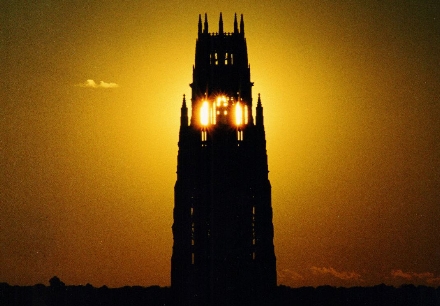
A beautiful shot of sunset through the Harkness Tower at Yale. Edward Harkness paid for the Harkness Memorial Quadrangle to be built in memory of his brother Charles, who died during the Great War. In addition to being a significant benefactor of Yale and St. Paul’s School, both of which he graduated from, he was also a patron of the University of St Andrews, where he was good friends with Principal Sir James Irvine.
At St Andrews, he built St. Salvator’s Hall, the first hall of residence for men since the end of the residential aspect of the colleges, as well as funding the renovation of the St. Salvator’s Chapel. His generosity is commemorated by a window in the chapel.
The trust he established also later paid for the restoration of St. Leonard’s Chapel, which had been abandoned in the middle of the nineteenth century.
Who’s still afraid of Keith Windschuttle?
Published in

By Ean Higgins
July 22, 2004
AS the elite of the nation’s academic historians met in the stately rooms of the Newcastle Town Hall, fear and loathing lurked the corridors.
The Australian Historical Association spent virtually an entire day trying to work out strategies to deal with the menace. Would there be safety in numbers if academics stood together? What should be done when the terror struck again? How could anyone survive when the mass media was in on the conspiracy?
Over 18 months after Keith Windschuttle published his book The Fabrication of Aboriginal History, the academic world is still anguishing over its impact. It is terrified of what he will do next. Windschuttle struck at the heart of the accepted view of Australian colonial history in the past 30 years – that the settler society had engaged in a pattern of conquest, dispossession and killing of the indigenous inhabitants. The facts, he said, did not stack up.
The Sydney-based writer, among other things, questioned the references used by academic historian Lyndall Ryan to justify her claims that the British massacred large numbers of Aborigines in Van Diemen’s Land in the early 1800s. Her footnotes supporting the claims did not do so, he wrote.
He also took on Henry Reynolds, the venerable historian of the Left, whose depiction of a brutal British conquest of Tasmania had been the accepted norm.
Reynolds’s work on the concept of terra nullius — that the British seized Aboriginal land based on a policy that it was owned by no one — developed such currency that it is believed to have influenced critical High Court judgments on land rights, including the Mabo decision. The thrust of Windschuttle’s thesis was that political correctness had triumphed over historical fact.
With the passage of time, the academic history profession is far from over the history wars. An extraordinary number in its ranks believe they have been been damaged by populist history propounded by Windschuttle. They are searching for a way out. Only a few seem brave enough to speak up, arguing that freedom of expression is the primary issue.
At the recent conference, Ryan made some effort, though ultimately unsuccessful, to avoid media coverage for a talk she gave entitled How the Print Media Marketed Keith Windschuttle’s The Fabrication of Aboriginal History: Implications for Academic Historians.
She said the media had taken up Windschuttle as representing the real history of colonists’ relations with Aborigines, grabbing the view that Australians had been hoodwinked by the academic left-wing historians’ version. “I don’t think the media owns free speech,” Ryan said. She had also been shocked, she said, that Stuart Macintyre, the influential left-leaning University of Melbourne historian, had appeared to criticise her over footnote inaccuracies.
She did admit to five footnote errors, but said the primary sources verified her thesis and “the simple fact is that footnote errors do occur”.
Her abstract said: “The AHA and universities need strategies and protocols in place to address future assaults on academic historians.”
Ryan was not alone in promoting the Windschuttle-media conspiracy. The AHA president, David Carment, said the The Australian had deliberately timed the publication of its review of Windschuttle’s work for the summer of 2002. During holidays more academics were on leave, Carment said, and “less able to defend themselves,” and it was “a time when people were reading newspapers”. (In fact, newspaper circulations fall away over summer holidays.)
It might be time, Carment said, for the association to “defend its people on the basis of their professional integrity” while not taking sides in the debate.
Carment also raised, though he did not fully support, the concept put forward by West Australian historian Cathie Clement for a code of ethics that would gag historians from criticising the integrity of their peers in public. Several in the audience said everyone had to be ready to counter-attack when Windschuttle came out with his next book.
Richard Waterhouse from the University of Sydney, said academics took Windschuttle too seriously. “Sometimes we have tended to treat him as an intellectual equal,” Waterhouse said, adding that sarcasm might be more appropriate. (Windschuttle earned a first-class honours degree in history from the University of Sydney in the 1960s, lectured in the subject, earned a masters in politics and left Macquarie University in 1992 when he set up a publishing house.)
There were a couple of muted mutterings from the audience about how it would be necessary to learn media skills, and not attempt to look like academics defending their own cabal. But nobody at the session publicly asked the key question which was in some of their minds: was the academic historians’ fear of Windschuttle and newspaper opinion pages absolutely paranoid?
Greg Melleuish, from the University of Wollongong, says he is intimidated by the pack mentality of the Newcastle meeting. “I was quite astonished,” he says. “It was like ‘let’s get a group of people together to ambush Windschuttle’. I think they feel under threat and that’s why they concoct these conspiracy theories.”
Other historians have expressed alarm at the attitude of their peers, including classical studies historian Ronald Ridley at the University of Melbourne. “The way they have shut down the debate, if they have made some errors, is really appalling,” he says.
“I don’t think any historians of Greek or Roman history would make these mistakes. And when you deal with issues such as indigenous history, the politics are red hot. You don’t just have to be a competent historian, you have to be top class.”
The question is why academic historians are so concerned about the impact of Windschuttle.
Macintyre, while he does not accept Windschuttle’s suggestion of a fabrication, does warn that mistakes can have a broader effect.
“There is an understandable public concern about the accuracy of historians’ work,” he says. At the same time, Macintyre maintains, Windschuttle fits with a conservative agenda to lift a burden of national shame from Australian shoulders over the Aboriginal issue.
Macintyre told the conference the history wars fitted in with broader “political dimensions” of the Howard Government’s “abandonment of reconciliation, denial of the stolen generations, its retreat from multiculturalism and creation of a refugee crisis”.
“Windschuttle was the first conservative intellectual to base his case on substantial historical research,” he says.
Windschuttle says this is precisely why the academic community is still so scared of him. “There is a whole generation who have invested not just their academic capital but also their political capital in the Henry Reynolds view,” he says. And, says Windschuttle, he has made Australian history interesting again for high school students who are more likely to go on to study it in universities.
While not referring to the Windschuttle debate, NSW Premier Bob Carr, a longstanding history buff, said much the same thing at the conference.
“History is an argument and the more argument there is in it the more young people will read it,” he said.
Ah, St Andrews!
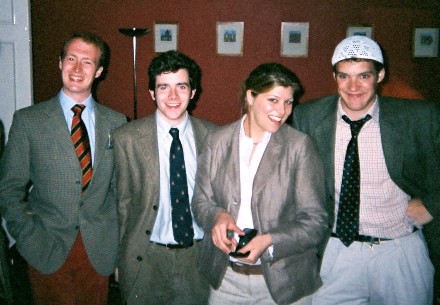
Was feeling a bit nostalgic for St Andrews. Won’t be heading back until Sept. 20, so I figured I’d put up a photo of fellow St Andreans and me with jovial countenances.

And the mantle from my room the past year. For a closer up look at the random items including architectural books, John le Carré novels, the program from the Knights of Malta ball, a bottle of cheap red, the Penguin editions of Gerald of Wales, and Alfred the Great, and R.G. Cant’s history of St. Salvator’s College, click here.
Long Live Our Holy Germany!
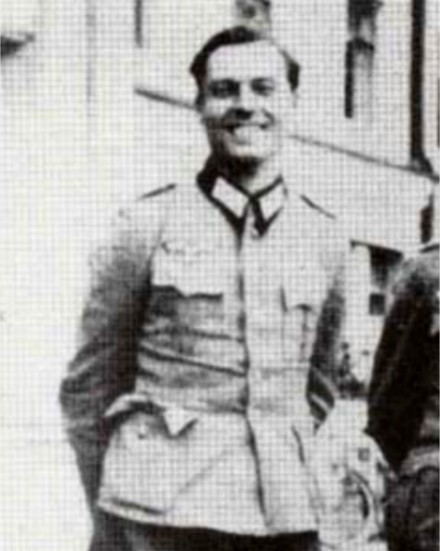
It was July 20, 1944, sixty years ago today, that Col. Claus Schenk Graf von Stauffenberg was executed for his masterminding the plot to kill Adolf Hitler. Stauffenberg was a devout Catholic who became convinced that Hitler was an Antichrist.
“Fate has offered us this opportunity, and I would not refuse it for anything in the world. I have examined myself before God and my conscience. It must be done because this man is evil personified.”
His uncle, Graf (Count) Nikolaus von Üxküll, recruited him into the resistance movement after the Polish campaign in 1939. After a series of missed opportunities, Stauffenberg finally placed a bomb to kill Hitler. Unfortunately, it was moved to the other side of a strong oak table supporter, shielding Hitler from the full force of the blast. Claus Philip Maria Shenck Graf von Stauffenberg was shot by the Gestapo at half past midnight that same evening.
His dying words were “Es lebe unser heiliges Deutschland!” – Long live our holy Germany.

Patroness of the Americas
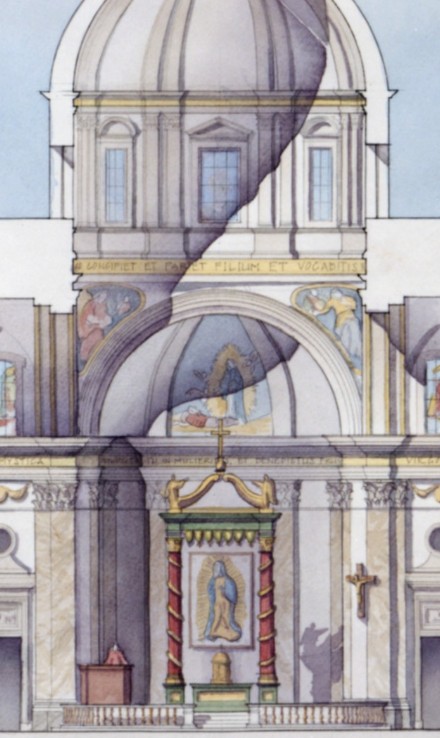
The ground has already been broken on the new Shrine of Our Lady of Guadalupe in the Diocese of La Cross, Wisconsin. La Crosse was formerly home to Archbishop Raymond Burke, one of the best bishops in our country. Burke has since been moved to the see of Saint Louis in Missouri. God willing, New York might get him some day, though Los Angeles could certainly use him more.
Blessed Virgin of Guadalupe, pray for the Americas, that we may become a beacon shining forth the light of Christ to all the nations.
Hail Mary, full of grace, the Lord is with thee. Blessed art thou amongst women and blessed is the fruit of thy womb, Jesus. Holy Mary, Mother of God, pray for us sinners, now and at the hour of our death. Amen.
Universitas Yalensis
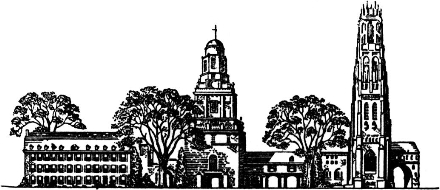
The Yale University Library has a very interesting online exhibit worth visiting called Building a University: 1919-1940. It tracks various plans for the improvement of Yale’s campus during the first half of the last century.
Yale is a truly beautiful place, and home to works by some of my favourite architects (James Gamble Rodgers and Betram Grosvenor Goodhue). I remember upon visiting Yale that the Sterling Memorial Library was so comfortable that I feel asleep. (More likely I feel asleep because I was reading Toni Morrison for school, horrible drivel!).
I do rather admire Yale though. Of all the New World Universities it probably ties with the University of the South.
Chartres 2004
Here are some photos from this years Pentecost Paris-Chartres Pilgrimage. (more…)
Vive le Roi!
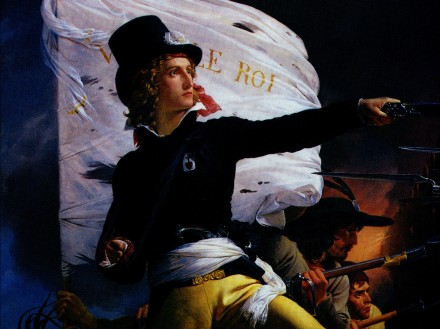
Today we should remember the victims of the French Revolution: the 4,000 prisoners drowned in the Loire by the Republic; the 2,000 Vendéens shot at Angers, half of them women; the 1,500 on the Ile de Noirmoutier; the 1,500 killed in the forest of Vezins; the 800 in the quarries of Gigant; and of course the King, his Queen, and their young son.
The Death of Marat
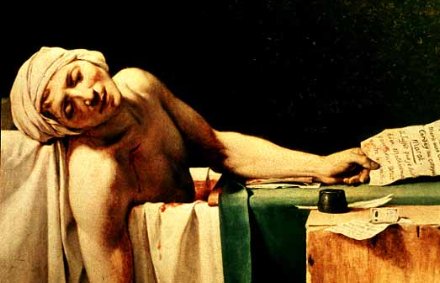
The thirteenth of July is also the day that the brave heroine of France, Charlotte Corday, killed the murderous revolutionary swine Jean-Paul Marat. Marat received his M.D. from St Andrews, and his villainy is remembered in the annual Kate Kennedy Procession, in which he is rightfully described as a “paranoid demagogue.”
The assasination inspired David to paint his famous depiction of the event. It is one of my favourite paintings, and a brilliant piece of propaganda portraying a bloodthirsty hatemonger as an angelic martyr.
Remembrance via the great Irish Elk.
Bo Bartlett, The Bride
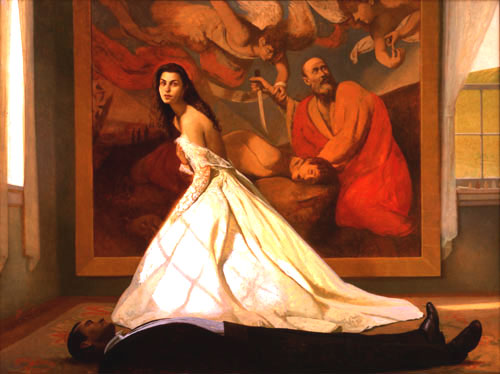
Bo Bartlett, The Bride
Oil on linen, 80″ x 100″
Private collection
Hamilton Hall Will Be Sold
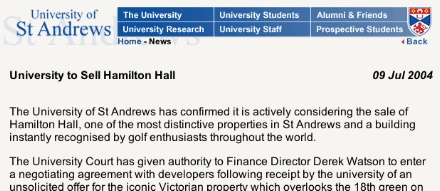
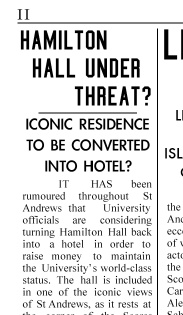 Yesterday, the University officially announced that it has decided to sell Hamilton Hall, the iconic red-brick residence hall that overlooks the Royal and Ancient Golf Club and the 18th hole of the Old Course.
Yesterday, the University officially announced that it has decided to sell Hamilton Hall, the iconic red-brick residence hall that overlooks the Royal and Ancient Golf Club and the 18th hole of the Old Course.
No surprise to Mitre-readers, as we reported this possibility before any other newspaper (university or otherwise) over four months ago, in our edition of March 2, 2004 (see at right).
I have to admit, losing Hamilton is slightly saddening, but having only been acquired in 1949 it is not an historic part of the University, as Finance Derek Watson points out in the press release. Nonetheless, if it does become a hotel, old students coming back years from now will be able to stay in their old rooms.
It’s a good move by the university, and the developers who want to buy it have guaranteed to provide newly-built accomodation before the sale goes through. The only trouble with this is that it seems unlikely this accomodation will be in town. Thus we may have another Fife Park/DRH situation on our hands. University Hall was far enough for me when I lived there!
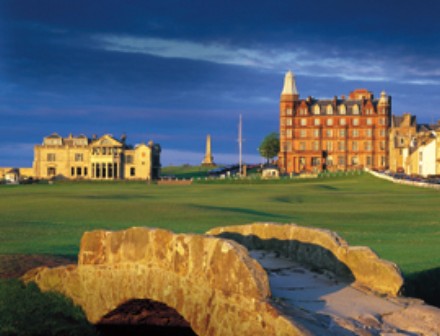
The Royal & Ancient on the left, and Hamilton Hall on the right.
Shakespeare the Catholic?
The debate continues:
In his lifetime, English priests could train only on the continent in Flanders or France. Some guess the arrest and horrific execution of the Jesuit missionary Father Edmund Campion persuaded the young Shakespeare to change course.
Catholic faith and sympathy for those suffering under the anti-Catholic reign of Queen Elizabeth and King James I. Scholars are also marshalling historical evidence that suggests Shakespeare was in fact allied to England’s “old faith” — that of the Catholic Church.
TCR News
Muggeridge on Orwell
Read this interesting piece on George Orwell by none other than Malcolm Muggeridge.
A tribute to Otto Clemson
A tribute to Otto Clemson Hiss:
Frau Hoffner: Hmmm, it is little Otto. He was one of your mother’s lovers. We often find him lying around.
Mata Bond: Is he dead?
Frau Hoffner: Hard to tell. He always looked like that.
Pensées des Journaux
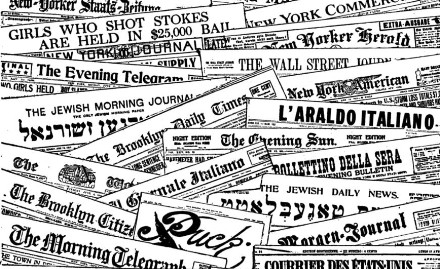
TODAY I WAS wondering how many daily newspapers there actually are in New York. I thought I knew all the English ones, the Spanish ones, and that there were a few Chinese ones as well. So my vague idea was somewhere around seven or eight.
After turning to the Encyclopedia of New York and the internet, by my count there are thirty-five dailies in New York, printed in nine different languages!
Eighteen English, five Chinese, three Korean, three Spanish, two Greek, one Italian, one Polish, one Russian, and one Ukrainian. That’s a very large number of newspapers for one city to sustain, though it ought to be remembered many of the language papers are purchased widely in other areas. Still, I wonder if Tokyo, Mexico, Seoul, Sao Paolo, Mumbai, and the other megacities out there have as many daily newspapers.
The eighteen English dailies by founding date are: (more…)
Bo Bartlett, Leviathan
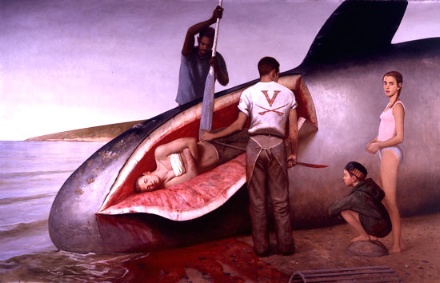
Bo Bartlett, Leviathan
Oil on linen, 89″ x 138″
Private Collection
Scott Fraser
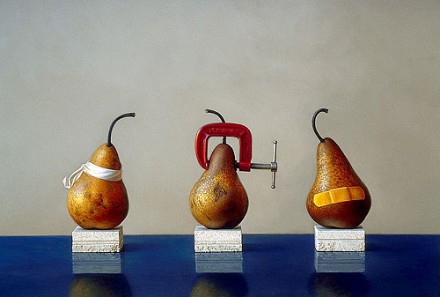
Scott Fraser, See No Evil, Hear No Evil, Speak No Evil
Oil on Board, 9″ x 17″
Private Collection
Search
Instagram: @andcusack
Click here for my Instagram photos.Most Recent Posts
- Burns Tower April 19, 2024
- Patrick in Parliament March 18, 2024
- Articles of Note: 13 March 2024 March 13, 2024
- Cambridge March 9, 2024
- Taken on Trust March 4, 2024
Most Recent Comments
Book Wishlist
Monthly Archives
Categories


